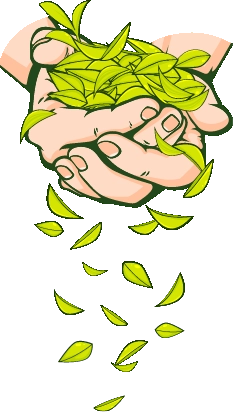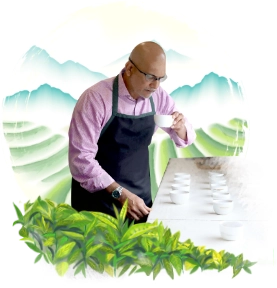White as Cloud
‘White as cloud, pure as snow, aromatic as orchid’ – this is how poets in China described White Tea. It is one of the most delicate and least processed of all teas. And it is very, very rare…because it is made only from the fresh, tender, young buds even before the leaves are fully open. These young buds are still covered with fine white hairs when plucked, giving these teas their famous pale white appearance and name.
Contrary to popular belief and (mis) conception, White Tea comes from the same tea plant – Camellia Sinensis as does green tea, oolong tea or black tea. White Tea (or any other tea) does not grow in any special type of tea plant. The leaves of Camellia Sinensis or the tea plant, when processed differently, give us green tea, oolong tea and black tea depending on how much they have been oxidized.
On a lighter note, there are some people who think that White Tea is what you get when you add lots of milk or cream or whiteners to black tea!
Origin
In medieval China, tea drinking had become an integral part of culture, highly respected and revered by the emperor and the royal family. It was a regular custom to present teas made plucked from the rarest, youngest and best buds from the finest tea plants to the emperor as an imperial gift. It is said that there were even secret imperial tea gardens that only produced the most rare and prized teas for the emperor. These artisanal teas, hand-picked and hand-made, are considered the earliest examples of white teas. But they did not look like the white tea we have today! The earliest white teas were plucked in spring and immediately steamed. Then, the outer leaves were carefully removed, exposing only the tender, white buds. These delicate buds were then delicately washed with spring-water and dried. They were then ground into a fine power, similar to the green matcha tea we have today. These white teas were then whisked in hot water to create the most expensive tea of the day.
Since those medieval times when White Tea was only made in China, today White Tea is also made in Darjeeling (India) as well as Sri Lanka. However, due to distinct cultivars, Chinese White Teas (from Fujian and Fuding) are quite different to the White Teas made in Darjeeling and Sri Lanka.
Process
While White Tea is no longer prepared as fine white powder, the process of manufacturing White Tea remains what it was centuries ago in China. The new, tender buds are hand-picked by skilled pluckers with nimble fingers and years of experience. They are gathered in bamboo baskets lined with a very clean white cloth. They are then withered and dried outside in the sun for a few hours, and then taken indoors for indoor withering. It can take up to 72 hours for the white buds to loose most of their moisture. In case there are also tender leaves with the buds, they are given a light hand-roll. Rolling is totally avoided if there are only buds. The teas are then quickly fired at 110° C to bring the moisture to 1%.
While this appears to be a simple process, controlling the temperature and time are extremely critical. It takes years of experience to master the fine art of making White Tea.
White Teas are the least processed and therefore, least oxidized of all teas. However, it is wrongly assumed that they White Tea are non-oxidized or fermented as minimal oxidation does take place.
Preparation of White Tea
White Tea is one of the more subtle and delicate of all teas. As a general rule of the thumb, the more delicate the tea, the lower the temperature it should be brewed at. Always refer to brewing instructions on the pack, as White Teas from different origins can have different brewing times and temperatures.
Usually :
- Use fresh, filtered water
- Brew at 190° F (88°C)
- Brew for 3-5 minutes
- In case of more delicate White Teas, steep at 160°F-180°F (70°C-80°C) for 2-3 minutes
- Use 2gm of loose tea for 8 oz serving
- Warm the tea-pot and keep it covered white tea is steeping
- Good quality loose White Teas can be steeped multiple times
Because White Teas are so fine and delicate, they should be enjoyed in their purest form – without milk or sugar, to experience their subtle and exquisite flavor.
Popular White Teas
The most popular White Teas are from China – Bai Hao (Silver Needles) and Bai Mudan (White Peony). Both these are exclusive grown in the Fujian province of China.
Bai Hao
Bai Hao is the original Chinese Silver Needles, bud-only teas, exclusive to Fujian It is plucked during the first flush in Spring, usually March/April. These buds have the longest white hair, and hence, the finished teas are pale white in color. In 1858, a new variety of tea plant discovered in Fuding county in Fujian province and the Fuding Silver Needle tea was developed.
Bai Mu dan
The first Bai Mudan or White Peony tea was developed in 1922 in Fujian. Unlike Bai Hao, which is only made from buds, White Peony had buds and one of two young leaves. When made, these teas look similar to the peony flowers, and hence, the name.
It is interesting to note that since both Bai Hao and Bai Mudan are extremely rare, delicate and fragile, they could not be exported. White Teas were hardly available in the western markets till about fifty years ago. It was only around 1968 that improvements in processing techniques made it possible to package and export these teas on a regular basis.
Darjeeling White Tea
These White teas (both Silver Needle and White Peony) are made in the famous Darjeeling tea estates in India, renowned all over the world for their exquisite flavour and aroma. Darjeeling White Teas are made only at select, fresh tea buds at some estates in March/April with the arrival of spring. They are made with the same process as the Fujian White Teas.
And remember…
White teas are as close to pure and natural tea as possible as they are the least processed of all teas. They are also high in antioxidants – the compound that makes tea such a healthy beverage, and low in caffeine. With light, subtle flavor and packed with loads of health benefits, these rare teas are closest to the elixir of life : White as Cloud, Pure as Snow, Aromatic as Orchid!

Tea is a religion in the art of life.

